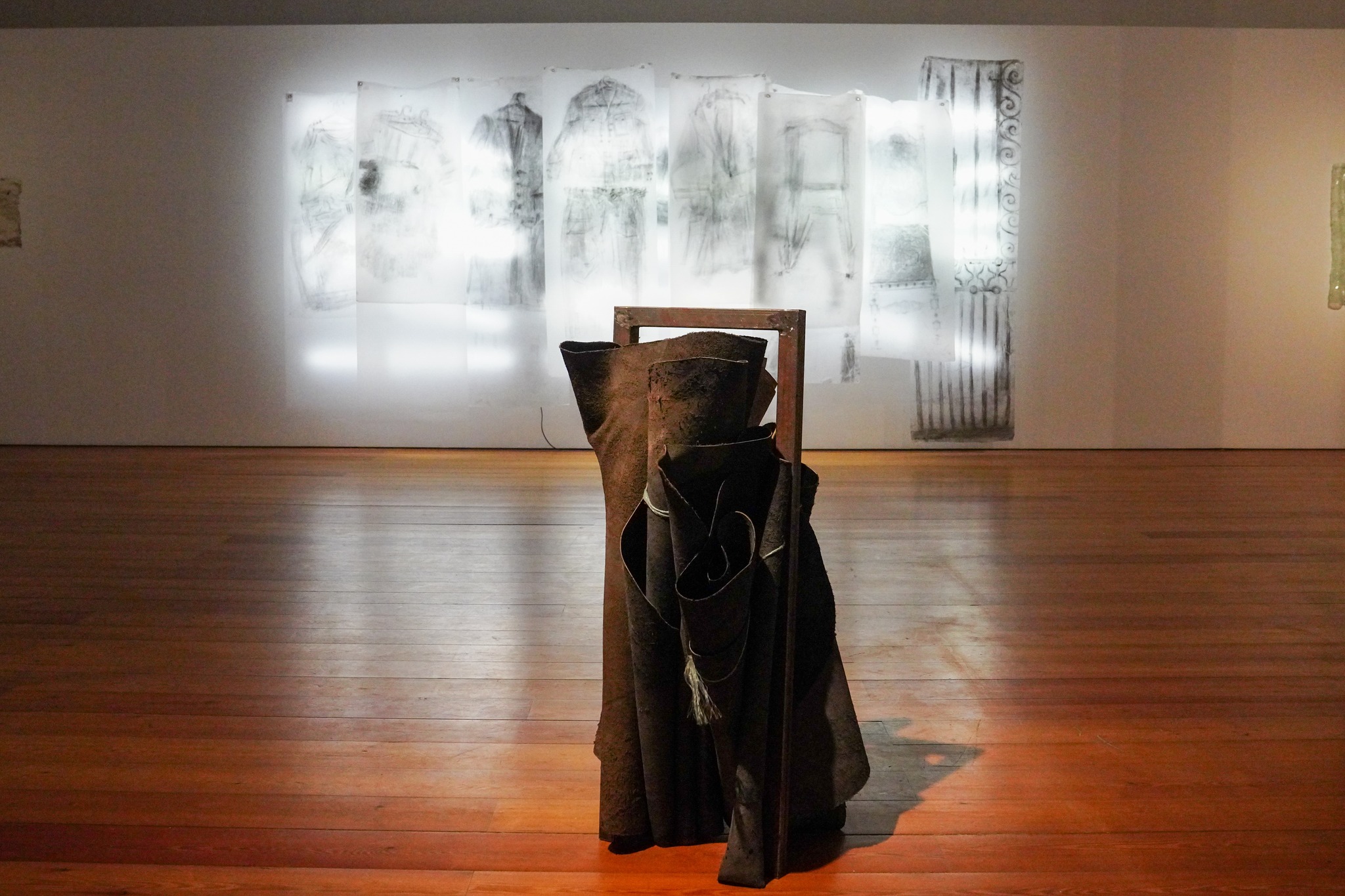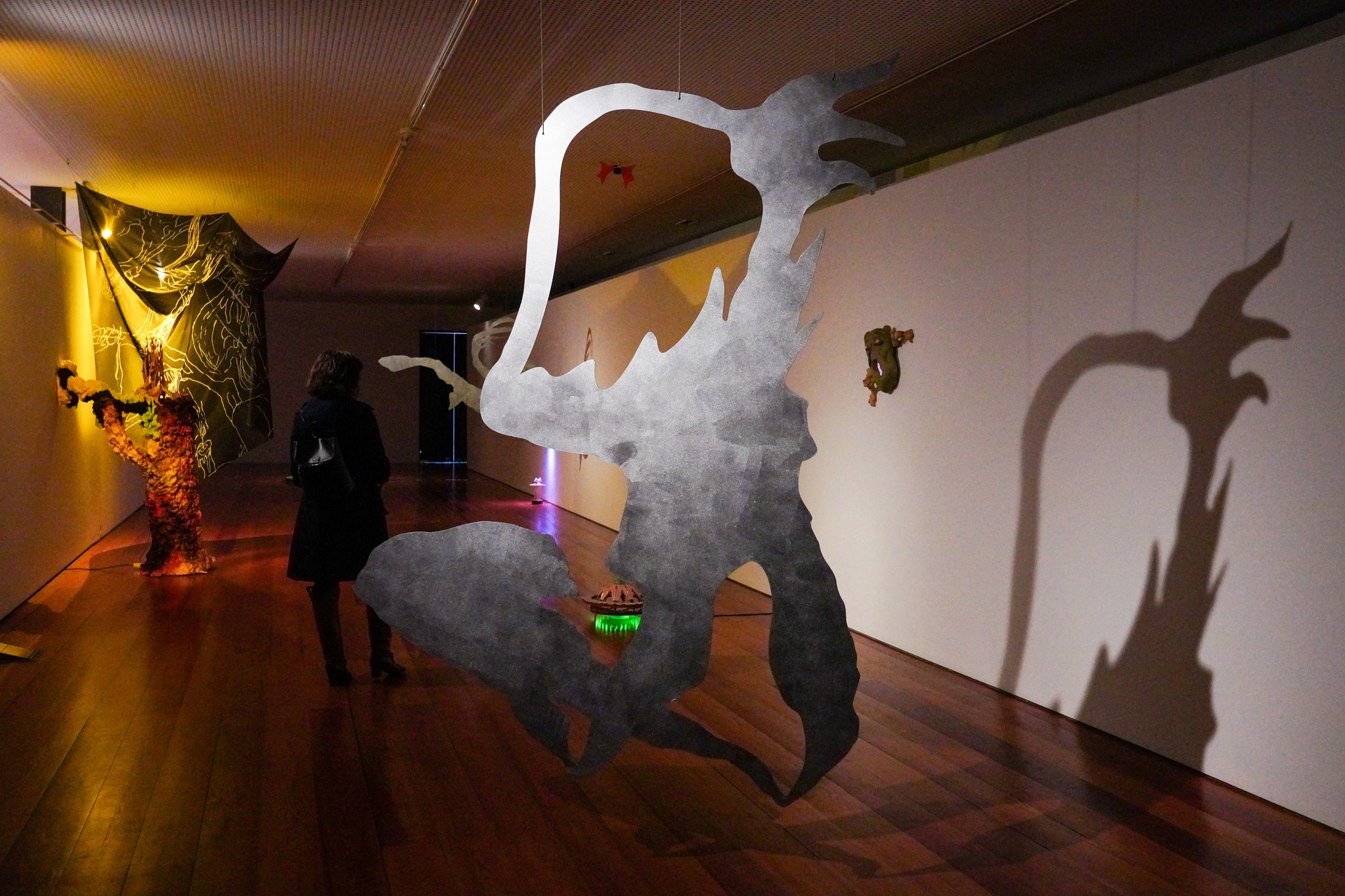AUTHOR: IVO MARTINS
EDITION: (Catalogue) Centro Cultural Vila Flor DATE: February 2024
When it begins... it does not end
To hold on to the notion of a pre-determined script about the meaning of a work of art is currently a suicidal approach; and, however, there is no doubt that humanity feels an urge for collective stories, that we are, as humans, attracted by the mysterious and tend to search for speculative answers for the unknown. Because the work of art is, by itself alone, a disquieting manifestation, something always in motion that escapes both space and time, it also begins in a flux whose current is full of incidents, topics and themes that we will try to capture throughout this essay. Similar to what happened to the artists during the assembly of this exhibition, we were also forced to cut, fracture, intermit, subtract linearities, extract orders, dishevel chronologies; or, in other words, to re-expose the ideas suggested by the works via its representation, reassociation and reintegration.
In the beginning of this process, we did not have in mind a clear point of reference that could function, according to an Euclidian perspective, as a steady and stationary framework of ideas. Without such a framework, the work of art becomes dominated by a sort of quantic disorder, a dimension of indetermination perceived in elements that are constantly changing as we look at them, always uncontrollable and always in process of mutation. We find ourselves in a cognitive realm where everything seems assembled at random, ephemerally, precariously, within a context where everything is calculated short-term.
When we contemplate the works assembled at the collective exhibition “Non-Observable Surfaces” we cannot help to feel that something is not completely finalized; we are not, therefore. captive of any pre-determined themes, concepts or evidences. We are then reminded of the supreme importance of the unfinished work as part of a greater whole which is impossible to discern in its totality – or, on the other hand, of the relevance of the artistic work as fugue, as a gesture of refusal of vulgarity and an attack against the banality of the discourses crystallized in so many of the contemporary images. This whole is made of successive partial acts, always and necessarily incomplete, developed in phases and inscribed on a movement whose field of vision, although paradoxically limited, simultaneous, semi-open and often closed, is being constantly reformulated. This kind of works of art both occupy space and generate their own (and ours) space; in short, they undergo a process of integration that merges into a context where every subject is recreated case by case, and defined by a mere glance.
Throughout this exhibition we discover elements that are common to all the works and that we unify and harmonize according to our references; and when these elements, although exhibited in all its diversity and multiplicity, come closer to us we create maps and guidance routes that allow us to elaborate compatibilities where everything is set apart, everything is liberated and everything imposes distance between subjectifiable bodies (objects).
Enrique Vilas-Matas calls unfinished works the literary pieces that, in the optic of the writer, would be the equivalent to impossible books. Accordingly, when we stand face to face to these “Non-Observable Surfaces” we have an intuition of something bigger, of a building in motion that overwhelms us, something that guides us towards a project which, by its own nature, is infinite; being finished presupposes death, the end in time, and the same occurs when we are confronted by the obvious, the self-evident, the closed, that which does not survive. How many versions there are of the same façade of a building, of a window, door, pavement, floor, wall, piece of cloth or leather…? (Mariana Maia Rocha); how many techniques do we know of reproducing the same object, in a clear allusion to mass-production, the copy of a copy that defines the images of our digital world? In painting (nitid, simple, aerial, almost white) there is always a hand behind, a gesture that expands and multiplies itself in successive versions of the same, through a white light that evolves in the form of spasms of white (Igor Gonçalves). How many versions of the same story do we find in a set of sculptures full of fragmentations, rarefactions, deformations, strange mixtures of bodies and litter that may possibly be the objects of a cult, remixed in bizarre ceremonial configurations, shamanic rituals on the border of ecstatic animism…? (João Melo) The images in motion position us in inhabited, closed, deep, infinite, endless, places; holes that entrap us and, in a certain way, convey an idea of eternity. Bodies float through those places, for example a torso anxiously trying to find a unfindable exit; or a sculptural, almost human, body that lets a fabricated, cold and diffuse light pass through its small overtures, allowing vision to roam through fissures and crevices cut inside many other things.
When we look at an image we infuse it with meaning; we introduce new categories of things that are ours: always contingent, always temporary, always personal. While advancing through that journey, we create new formalizations and eventually come across an emptiness that is more disposed to surprise us or, in alternative, to be sucked by what it is in itself within an austere and strained environment (Igor Gonçalves). This void creates precipices, non-definable spaces that both attract and astonish us (Diogo Matins); and, however, in this astonishment there are traces of images murmured by drawings of façades, pavements, doors, windows or simple pieces of leather or glass, within a variety of accumulated and worked-out objects (Mariana Maia Rocha) – works that guide us towards reminiscences, memories, references of a past that is always present, although always absent. The image ceases to be explicative to become descriptive; and when it becomes descriptive, it necessarily loses its symbolic energy and transforms into mere expedients of interpretation that, in reality, do not have much to say to those who are outside those inner – either individual, collective, social, natural or cosmological – worlds (João Melo).
Diogo Martins projects us into closed environments, points of closure, underground routes, reticular paths, organized or disorganized in exit-less places, a world in process of creation and expansion that reveals depth and labyrinthic intensity; Igor Gonçalves guides us to sensations of emptiness, exercises of contention, ways of bereavement, approaches reunited in successive waves of silence and light; João Melo confronts us with rituals of obscure and syncretic magic, through associations and dispositions between objects and symbols that can, at the same time, by the equipment of a strange ritual, a form of magic that is completely unknown to us, but that we can only imagine; Mariana Maia Rocha offers us spatial and temporal reverberations in resonances, echoes, visual vibrations of several surfaces and moments, expanded in specters that return to us as memories and revisitations of the present, the past and the future. Therefore, while Igor is void; Mariana is grey; João, colors; Diogo, movement; and each one of them lead the gaze of the spectator while reformulating images that convey signals, more signals than words.
In this process of producing a consistent explanation to art, new signals, new data, or new situations emerge and function as provocations. These appear as misleading exits to a path that, in reality, does not exist, because we prefer to be confronted with spaces without continuity and depth where we lose ourselves in a circle of oblivion, absorbed by an unreality devoid of an objective or rigorous determination.
If we write it is only because we feel an urge to reiterate; we need to retrieve what we contemplate as an ultimate process of perfectioning our eyes; we need to persevere, even if that means taking the risk of repeating ourselves. And how often from our ideas new conceptual nothings emerge, nothings that are beginnings and seem promising. However, in the end, everything remains unfinished:
The sentiments based on good feelings and in occasional intuitions we believe to be the best (Igor Gonçalves);
The seemingly random elements binding us together and providing a perspective of the whole which keeps appearing and disappearing, despite the images we rob from the daily life, images that, although apparently topical, are in fact timeless (Mariana Maia Rocha);
And the moments when each work connects with the others that are closer to it, generating continuous processes of survival and narrative fabulation within closed environments (Diogo Martins and João Melo).
This means that we position ourselves between what is complete, fixed, exhausted, finalized, definitive, and what manifests itself in the form of something incomplete and impossible to explain. This exploration of opposites compel us to think that we are always going back to a new beginning; not necessarily the beginning of what is resolved, but of that which will come.
TRANSLATION: MANUEL JOÃO NETO



